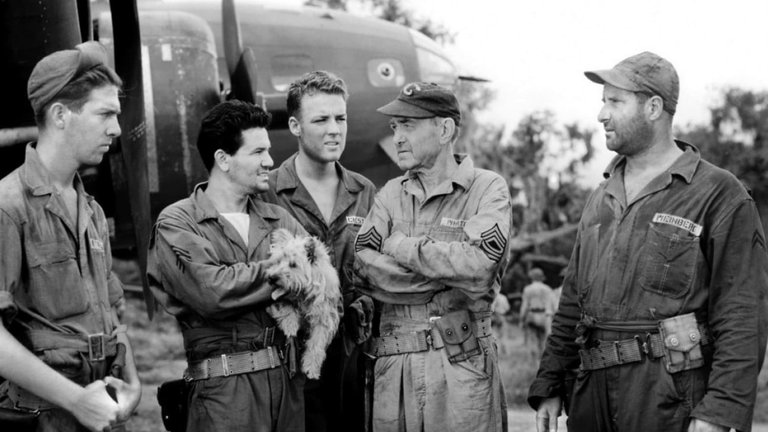Film Review: Air Force (1943)

When there is a need for propaganda films, it is always better if they are made by someone with experience and genuine talent. In WW2 USA that someone was Howard Hawks, one of the most celebrated directors of Classic Hollywood, whose 1943 film Air Force manages to transcend its propaganda purpose and can be still appreciated as fine piece of action cinema.
When the film was made, USA still didn’t have separate air service of its armed forces, and the title refers to US Army Air Force, whose commander, General Henry “Hap” Arnold, came with the idea for the film shortly after Japanese attack on Pearl Harbor, which marked the entry of USA into Second World War. The plot refers and begins shortly before the event, on December 6th 1941 in San Francisco, where the crew of B-17 Flying Fortress bomber, nicknamed “Mary Ann” and commanded by Captain Michael Aloysius “Irish” Quincannon (played by John Ridgley), is given order to fly to US base in Pearl Harbor. The mission seems routine and hardly dangerous, because USA is still in peace. Everything changes when “Mary Ann” arrives at its destination and its crew sees its base and other facilities devastated by surprise Japanese attack. They don’t get any rest, because Japanese have also attacked US forces at Philippines, which they need any plane that they can get in order to fend off superior enemy. Quincannon is ordered to fly at Clark Field airbase via besieged US garrison at Wake Island. When they arrive at their destination, crew of “Mary Ann” will experience the baptism of fire.
Air Force was produced when the war wasn’t going that well for USA and other allies and there was arguably more need for moral boosting war films than in later periods. Hawks, an accomplished aviator, seemed to be the perfect man for the job. He also understood that, since Americans used to look like underdogs during the first months of war in the Pacific, he had to involve action scenes in which they would triumph over numerically superior adversary through their courage, discipline and ingenuity. Those action scenes appear quite late in the film, but it is for good reason. Like in any good action film, audience need to be invested in fate of the characters, which means that script by Dudley Nichols (later polished by William Faulkner) had to allow viewers to know them better. Exposition takes almost hour and half, but it is very well made exposition that benefits well from Nichols’ decision to treat each of the characters equally. Nine members of “Mary Ann” crew might be different in rank, age, temperament or ethnic background (not racial, since US Army was still being segregated on racial lines during WW2), but each is given time to be developed and each is being played by a talented actor. Air Force doesn’t feature any major star, which also benefits the film, which doesn’t have to follow conventions of particular kind of character surviving the ordeal.
Air Force is also great from strictly technical standpoint. Warner Bros. studio enjoyed full support of US Army Air Force, which allowed use of real B-17 bombers and other aircraft (including Republic P-43 Lancers which stand for Japanese “Zeros”). This was matched by rather impressive special effects and miniature work that work very well during the grand naval battle at the end, an event that didn’t actually follow history but was inspired by Battle of the Coral Sea, being fought during the production. That scene is really effective, even with the use of documentary stock footage, seamlessly edited into the live action. Unfortunately, single shot of Austro-Hungarian battleship SMS Szent Istvan, sunk during First World War, will ruin that scene, at least for viewers familiar with history and sensitive towards such details. Even more problematic, at least from today’s standpoint, is an attempt to explain American disaster at Pearl Harbor with seemingly omnipresent Japanese American fifth column that sabotages airfields and takes pot shots at isolated servicemen. Those scenes, which had nothing to do with historical record, in many ways exploited and enhanced racist sentiments, and that makes Air Force one of the less acceptable US WW2 propaganda films, despite its technical and artistic qualities. When the war ended, film was mostly forgotten and is now considered one of the lesser works of Howard Hawks. Nevertheless, it was appreciated by true cinephiles, including Quentin Tarantino who would half a century later pay homage by one of the memorable scenes in his Pulp Fiction.
RATING: 7/10 (+++)
_
Blog in Croatian https://draxblog.com
Blog in English https://draxreview.wordpress.com/
InLeo blog https://inleo.io/@drax.leo
InLeo: https://inleo.io/signup?referral=drax.leo
Unstoppable Domains: https://unstoppabledomains.com/?ref=3fc23fc42c1b417
Hiveonboard: https://hiveonboard.com?ref=drax y
Bitcoin Lightning HIVE donations: https://v4v.app/v1/lnurlp/qrcode/drax
Rising Star game: https://www.risingstargame.com?referrer=drax
1Inch: https://1inch.exchange/#/r/0x83823d8CCB74F828148258BB4457642124b1328e
BTC donations: 1EWxiMiP6iiG9rger3NuUSd6HByaxQWafG
ETH donations: 0xB305F144323b99e6f8b1d66f5D7DE78B498C32A7
Posted using CineTV